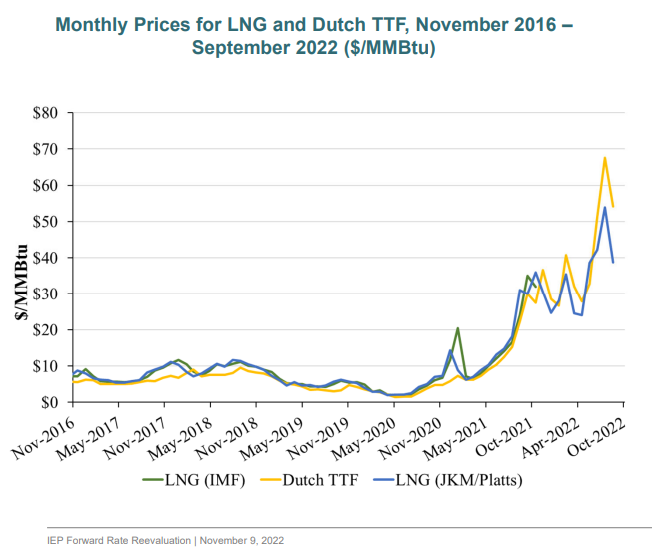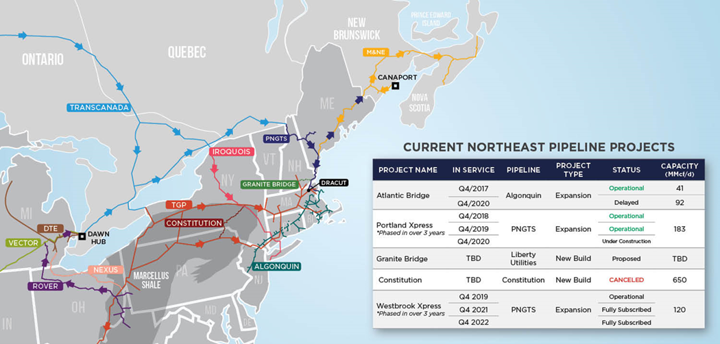
By Max Webb, Managing Director of Pricing and Larry Pignataro, Director of Strategic Partnerships & Senior Energy Services Advisor
Max Webb and Larry Pignataro support Competitive Energy Services’ clients from two divergent, yet complementary vantage points. On a daily basis, Max seeks to understand and add meaning to complex pricing components that are important to clients in countless ways. Without missing a beat, Larry adeptly manages client relationships, fields client questions and inquiries, and is an integral member of our Energy Services Advisory team that guides and supports clients as they consider their energy future -- all while helping them navigate today’s complex energy market. The crossover juncture where Max and Larry meet is their dedication to clients and wisely guiding them as they make short- and long-term energy-related decisions. With our clients (current and future) in mind, Max and Larry collaborated on this blog piece on fuel security – a topic that clients regularly ask about and is ever-present in today’s changing energy landscape.
What is Fuel Security?
Fuel Security is a concern across the country as we decarbonize energy systems, switching from legacy fossil fuel sources of power generation to low and zero carbon alternatives. . As coal, oil and dual fuel power generation assets retire - making way for solar, wind and battery storage – regional grid operators need to make sure that enough fuel will be available to power plants at the right time and location. The Independent System Operator of New England (ISO New England) has instituted a “Fuel Security” program that permits them to retain these assets during peak winter events to ensure system reliability and the fuel used to run those assets.
A prime example of the New England fuel security problem occurred a few years ago when a weeklong stretch of extreme cold weather from December 26, 2017 through January 8, 2018, caused significant natural gas demand and high prices. This occurrence proved to be one of the catalysts of why the Fuel Security program exists today. During that stretch, gas prices increased, in turn spiking costs for natural gas generators to higher than oil or coal generators, and which subsequently caused the region to burn more than 2 million barrels of oil to generate electricity. To top it off, there were multiple snowstorms during that time causing logistics of deliveries for oil to be significantly interrupted. As a result of this event, a more detailed forward analysis was implemented by the ISO in 2018. Concurrently that same year, the owner of Mystic Generating Station, a large generator located outside of Boston that is fueled by imported liquified natural gas, announced its plan to retire in 2022. ISO New England identified severe consequences with retiring this plant and came up with a plan to retain Mystic through 2024. This is how the Fuel Security program was born. In 2020, an additional program was added for Inventoried Energy, covering the winters of 2023-2024 and 2024-2025 which recognizes assets that can store fuel for use when the grid is most stressed.
Program Deep Dive
The two current Fuel Security programs in the New England region are: Mystic Cost of Service and Inventoried Energy. Let’s take a closer look at each of these programs and why they are important to every energy user in New England.
Mystic Cost of Service is top of mind when thinking about fuel security costs. If you’ve received electricity supply quotes in the last year from Competitive Energy Services, it’s likely you have seen or heard this program mentioned. As stated in Section 1, Mystic Cost of Service is a program designed to retain the Mystic Generating Station for an additional two years beyond its initial retirement date. Unfortunately, Mystic couldn’t keep the lights on for free, so as a result, ISO New England (ISO-NE) and the Federal Energy Regulatory Commission (FERC) created the Mystic Cost of Service program. The program boils down to the cost that all New England electricity end users are responsible for paying to keep Mystic running for this two-year period, which appears on the supply side of your electricity bill.
The cost of the Mystic Cost of Service program can be segmented into two categories: 1. known, fixed costs, and 2. unknown, variable fuel costs. In the first, the costs are the known, fixed costs which are collected to offset expenses such as operating and maintenance costs. These costs are relatively straightforward and do not really fluctuate. The second category is trickier because part of the cost is unknown and variable. This aspect of the cost equation has ties to New England and global energy markets. Since no one has a crystal ball, it has proven difficult to forecast how much the variable, market exposed piece of Mystic Cost of Service will cost. This variable cost is the major reason why Fuel Security Mystic Cost of Service has been top of mind for almost a year now. In section 3, we’ll go a little deeper into why that is.
The second Fuel Security program is Inventoried Energy. The purpose of Inventoried Energy is to ensure that generators have enough fuel stored on hand during the peak winter periods to meet demand. The program targets the next two winters (December 2023 – February 2024 and December 2024 – February 2025) to buy us some time while other solutions are implemented to solve New England’s fuel security concerns. The Inventoried Energy program provides generators additional payments to cover their cost of storing extra fuel for the next two winter periods if they can prove they are eligible. The eligible generator list was tailored to reflect the fuel sources that are likely to be available when they are needed. For example, eligible resources include batteries, coal, and oil while ineligible resources include wind and solar. The reason is because batteries, coal, or oil generation can respond quickly to peaking demand when called upon compared to wind and solar which require the wind to be blowing or the sun to be shining, which can’t be guaranteed at any given time.
The cold snap during winter 2017-18 opened some eyes and sparked action to ensure New England’s energy grid can meet demand during peak periods, and New Englanders have been lucky enough to avoid major disruptions since. You only have to look back a couple of years to Winter Storm Uri and the impact it had on the Southern U.S. to see what happens when the grid cannot meet demand. During some of the coldest temperatures Texas and many other Southern states have experienced, the two major regional electricity grid operators -- Southwest Power Pool (SPP) and Electric Reliability Council of Texas (ERCOT) -- had to order rolling blackouts across the Southern U.S. because there were not enough electricity generators able to operate and meet electricity demand. Millions of residents were left without power for days which proved disastrous.
The New England energy grid is better positioned to perform during cold weather events than the South, however, Winter Storm Uri provides a chilling reminder of what’s possible if the grid fails when we need it most. This is why Mystic Cost of Service and Inventoried Energy was implemented as part of the plan to prevent a similar situation from unfolding in New England.
The Unknown Cost of Mystic
As mentioned above, the Mystic Cost of Service program originated in 2018. The actual term of the program started in June 2022. Now more than six months into the implementation of the program, most people are still scratching their heads over how much this program actually costs. The reason is due to the variable, market exposed nature of the program. Mystic burns imported liquified natural gas (LNG) to generate electricity. From 2018 into 2022, the price of LNG was relatively low and stable. Starting with the Russian invasion of Ukraine, LNG prices began to rise and peaked in the summer of 2022.
Figure 1: Monthly Prices for LNG and Dutch TTF. Source: IEP Forward Rate Reevaluation

Since LNG is Mystic’s primary fuel source, a large portion of the monthly cost to keep Mystic operating ties back to fuel cost. In a perfect world, Mystic would be economically dispatched to burn LNG to generate electricity when the New England grid needs it, which means high electricity spot prices would offset the high LNG fuel costs. Unfortunately, we don’t live in a perfect world and so far, that has also not been the case with Mystic. Weather is a huge factor in stressing the grid, so on the coldest days in the winter where everyone is turning up the heat to stay warm, ISO-NE needs to call on additional generators to meet demand. Since Mystic is being paid to essentially be on stand-by when we need it, they also need to have fuel on hand to burn. The LNG used at Mystic is imported by ship from other countries and these ships must be contracted and scheduled long in advance to ensure delivery. With the tight, tricky LNG market combined with the unpredictable nature of New England winters (50 degrees in January?!), we have found ourselves in a tough spot. Warm temperatures have led to lower spot prices, which means Mystic has not been able to economically burn the high-priced LNG fuel. As a result, rate payers must foot the bill for the difference to keep Mystic whole.
How Long is This Really Going to Last?
At the core of New England’s fuel security issue is the lack of a natural gas pipeline infrastructure in the region. Natural gas made up 52% of electricity generation in New England in 2022. While more than half of electricity is generated by natural gas, new pipeline infrastructure has not been built in the region which leaves the area with a very tight supply and demand problem. During extreme weather events, end users are turning up their heat at the same time we need that natural gas to generate electricity. Due to lack of pipelines, we essentially hit a cap on the amount of natural gas that can be imported into the region. We have to either curtail electrical load (blackouts) or turn to other fuel sources to make up the difference (fuel security programs).
Figure 2: Regional Pipeline Infrastructure. Source: Competitive Energy Services

While there are longer term plans in place to address the issue, such as changes to the Forward Capacity Market, in the short-term we rely on these fuel security programs. The natural gas pipeline issue is not going away any time soon, so while our electricity grid evolves to better serve our long-term needs and climate objectives, it’s likely we’ll see additional fuel security programs created in the interim. Incidentally, there was a third proposed fuel security program, Energy Security Improvements (ESI), that was rejected by FERC. It remains to be seen if it will be resurrected or replaced with a new fuel security program proposal.
As always, these programs are not free and are paid by all of New England ratepayers. These costs will be important to monitor to be aware of potential cost increases coming down the pike in the not-so-distant future.
Where do We Go from here?
End users of electricity who are in third party supply agreements need to understand their current contract terms and product options going forward for contract renewals when it comes to fuel security costs. Electricity suppliers are treating these costs differently because of the extreme market volatility we saw in 2022. Some things to understand are:
- Does your contract include these charges already?
- Does your contract state that these charges will be passed through to you at cost?
- Does your contract allow adjustment of your rate because of these charges?
- Is your contract bi-lateral where the supplier will adjust up OR down based on actual costs?
It’s important to read your contract thoroughly in order to understand what may or may not be included. If you are unsure about how these costs are impacting you, Competitive Energy Services is here to help guide you through details and help you make the correct assessment of current contracts and to help with analyzing forward contracts. To discuss, reach out to one of our Energy Services Advisors today!
